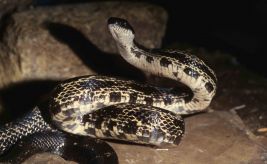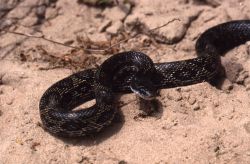Pantherophis spiloides (Dumeril, Bibron, & Dumeril, 1854)


Key Characters: Sides unusually straight, forming a sharp corner with the belly; back scales weakly keeled; anal plate divided. Juvenile distinctly marked with dark back and side blotches on a white or gray background.
Similar Species: North American Racer. Juvenile resembles many blotched snakes: Milksnake, young of Yellow-bellied Kingsnake. See the Key to Snakes of Illinois for help with identification.
Subspecies: None recognized, but see Nomenclatural History below.
Description: Large (up to 175 cm TL), dark snake with a highly variable pattern that ranges from a series of light blotches to completely black. The ground color between blotches darkens with age, obscuring most of them by 80 cm TL, except in extreme southern counties where remnants of the juvenile pattern are retained throughout life. Belly black-and-white-checkered. Adults have white, orange, or red skin between the dark scales.
Habitat: Variety of forest, shrub, and edge habitats. Common around farm buildings and abandoned houses.
Natural History: This arboreal constrictor often suns and prowls on tree limbs and rock outcrops where it feeds on birds, their eggs, and small mammals. Mates in April or June and l0-20 eggs between early May and July. Young (ca. 30-35 cm TL) hatch late July to September. Large adults have few predators other than humans. Carnivorous mammals and raptors are the main predators of juveniles.
Status: Locally common, especially in southern counties.
Etymology: Pantherophis- ?; spiloides – spilos (Greek) meaning spot, speck, blemish; -eidos (Greek) meaning form, reference.
Original Description: Dumeril, A.M.C. G. Bibron, & A. Dumeril. 1854. Erpetologie generale ou histoire naturelle complete des reptiles. Librarie Encyclopedique de Roret, Paris. Vol. 7 (Part 1). 780 pp.
Type Specimen: Holotype: MNHN 827
Type Locality: “La Nouvelle-Orleans” [= New Orleans, Louisiana]
Original Name: Elaphis spiloides Dumeril, Bibron, & Dumeril, 1854
Nomenclatural History: In the recent past, the nominal species inhabiting Illinois was considered to be Elaphe obsoleta (Say, 1823) with two subspecies, E. o. obsoleta and E. o. spiloides. Smith (1961) presented it in this manner. However, using molecular and morphological data, Burbrink et al. (2000. Mitochondrial DNA phylogeography of the polytypic North American rat snake (Elaphe obsoleta): A critique of the subspecies concept. Evolution 54(6):2107-2118) split E. obsoleta into three species, with no subspecies. P. spiloides is the species inhabiting Illinois. Utiger et al. (2002. Molecular systematics and phylogeny of Old World and New World ratsnakes, Elaphe Auct., and related genera (Reptilia, Squamata, Colubridae). Russian Journal of Herpetology. 9 (2): 105-124) used molecular data to show that the genus Elaphe as recognized is paraphyletic and assigned the New World members of the genus to Pantherophis Fitzinger, 1843. Davis & Rice (1883) listed the names Coluber obsoletus obsoletus, C. o. confinis (Baird & Girard, 1853), and C. lindheimerii (Baird & Girard, 1853) in their Illinois list.


